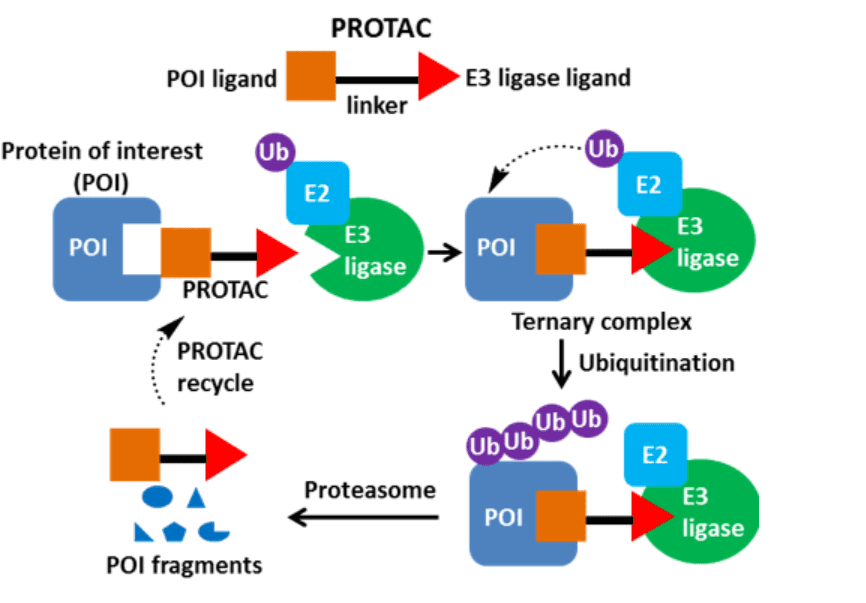BOC Sciences is a leading CRO with well-established PROTAC technology platform to help our customers accelerate the development of new drugs. Based on our advanced platform and expertise, we offer customized solutions for the development of PROTAC molecules for the treatment of neurodegenerative diseases.
What’s the PROTAC
PROTAC is discovered that by utilizing the body's natural protein cleaning system, it is possible to reduce protein levels rather than inhibit protein functions. As opposed to traditional small molecule inhibitors and antagonists, which inhibit protein function via the occupation drive mode of action, PROTAC plays a therapeutic role by inducing the degradation of pathogenic target proteins.
 Fig 1. Proteolysis Targeting Chimeras (Zhao, 2020)
Fig 1. Proteolysis Targeting Chimeras (Zhao, 2020)
What are the Neurodegenerative Diseases
Neurodegenerative diseases are a group of diseases that cause chronic progressive damage to nerve and other tissues for unknown reasons, manifesting as progressive neurodegeneration and necrosis, resulting in cognitive, emotional, and behavioral abnormalities. Parkinson's disease (PD) and Alzheimer's disease (AD), among others, are examples of representative diseases. The pathogenesis of AD is still unclear and remains at the stage of some hypotheses. The universally recognized pathological mechanism of AD is extracellular senile plaques formed by deposition of amyloid beta (Aβ) and Neuronal fiber tangles (NFT) formed by hyperphosphorylation of intracellular Tau protein. The formation of NFT containing hyperphosphorylated Tau is the result of an imbalance between Aβ accumulation and clearance. Tau protein is abundant in neurons and is expressed at a very low level in the central nervous system but accumulates before extensive neuron damage. Thus, Tau deposits have become a target for determining the progression and treatment of AD.
PROTAC in Neurological Diseases
There are some examples of PROTACs in neurological diseases treatment have been reported. For example, PROTACs with the E3 ubiquitin ligase-binding ligand (such as lenalidomide or thalidomide) can be combined to the Tau protein and subsequently induce tau ubiquitination and facilitate its degradation in cells. As tau aggregation, especially hyperphosphorylated tau, leads to tauopathies in AD, tau or any form of post-translational modification is targeted and E3 ubiquitin ligases such as Cereblon are recruited to ubiquitinate tau to mark it for degradation. Thus, PROTACs have promise for the treatment of neurodegenerative diseases, acting by targeting and promoting the degradation of disease-associated proteins.
Our Services
As a leading CRO in the pharmaceutical field, BOC Sciences is dedicated to the design, discovery, synthesis and optimization of effective PROTACs to assist our customers’ new drug development. We provide PROTAC molecules design services for neurodegenerative diseases treatment, including:
We also provide custom protein expression and purification services as well as target protein products including neuro-degenerative related proteins.
Our Advantages
- Customized PROTAC design services for neurological diseases
- Well-established PROTAC platform and one-stop service
- Quality services and products
- Data analysis, detailed results reporting and discussion
- Expertise and experienced scientific team
- Highly reliable and reproducible results
References:
- Zhao, H.-Y. et al. Discovery of potent small molecule PROTACs targeting mutant EGFR. Eur. J. Med. Chem., 2020, 208, 112781.
- Zempel, H. & Mandelkow, E.-M. Tau missorting and spastin-induced microtubule disruption in neurodegeneration: Alzheimer Disease and Hereditary Spastic Paraplegia. Mol. Neurodegener, 2015, 10, 68.
- Kaufman, S. K., Del Tredici, K., Thomas, T. L., Braak, H. & Diamond, M. I. Tau seeding activity begins in the transentorhinal/entorhinal regions and anticipates phospho-tau pathology in Alzheime’s disease and PART. Acta Neuropathol, 2018, 136, 57-67.

 Fig 1. Proteolysis Targeting Chimeras (Zhao, 2020)
Fig 1. Proteolysis Targeting Chimeras (Zhao, 2020)
